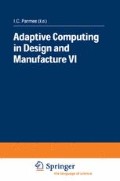Abstract
An adaptive controller that modifies its characteristics to deal with new situations, in a timely and accurate way, would be a valuable improvement on many existing industrial plant controllers. Furthermore, if such a controller could effectively be “strapped around” the existing controller then there could be many opportunities for performance enhancement of systems already “out in the field”. The new situations that this adaptive controller would need to deal with could arise from time variations in the plant’s characteristics due to wear and tear, or from learning, on-line, about unforeseen new parts of the plant’s operational envelope. The universal approximation abilities of neural networks, combined with permanently active on-line learning, yield powerful features that can be used to great advantage in creating adaptive controllers for such applications. Together they allow accurate control strategies to be developed for these types of plant without the need for a mathematical model. Furthermore, neuro-control algorithms can learn about these dynamical features using signals from the plant that are normally easily obtained. Multi-axis revolute-jointed robot manipulators are good examples of this class of plant. In order to illustrate some of the important advantages of these methodologies, and to inform the reader about some of the important characteristics of these adaptive structures, we review some of our recently reported experiments in applying an on-line learning neuro-control approach to joint level trajectory control of two different industrial robots. In each case, the neuro-controllers are used to enhance performance of the existing PID controllers. This paper is mainly concerned with highlighting these features via the experimental results. However, when a controller learns on-line whilst acting as part of a plant’s closed-loop controller, it is crucial that a careful and rigorous approach is adopted. A strict theoretical basis that guarantees the whole system’s stability is required. To set the experimental work in context therefore, we briefly review our on-line learning neuro-control method, which is used for both sets of experiments.
Access this chapter
Tax calculation will be finalised at checkout
Purchases are for personal use only
Preview
Unable to display preview. Download preview PDF.
References
Albus J S, 1975, A new approach to manipulator control: the Cerebellar Model Articulation Controller (CMAC), J. Dynamics Systems, Measurement, & Control, Vol.97, pp.220–227
Jin Y, Pipe A G, Winfield A, 1994, Robot Trajectory Control using Neural Networks-Theory & Puma Simulations, Procs. IEEE Int. Symp. on Intelligent Control, Columbus Ohio, USA
Jin Y, 1994, Intelligent Neural Control & its Applications in Robotics, Ph.D. Thesis, University of the West of England
Jin Y, Pipe A G, Winfield A, 1997, Chapter 5: Stable Manipulator Trajectory Control Using Neural Networks, Neural Systems for Robotics, Academic Press, ISBN 0-12-526280-9
Kadirkamanathan, Niranjan, 1992, A function estimation approach to sequential learning with neural networks, Cambridge University, Eng. Dpt
Lenz A, Pipe A G, 2003, A Dynamically Sized Radial Basis Function Neural Network for Joint Control of a PUMA 500 Manipulator, Procs. IEEE Int. Symp. Intelligent Control, ISBN 0-7803-7892-X, pp.170–175
Leong, Saratchandran, Sundararajan, 2002, Real-time performance evaluation of the minimal radial basis function network for identification of time varying nonlinear systems, Computers and Electrical Engineering, vol. 28, pp.103–117
Lewis F L, Jagannathan S, Yesildirek A, 1999, Neural Network Control of Robot Manipulators & Nonlinear Systems, London, Taylor & Francis
Lutz, Wendt, 1998, Taschenbuch der Regelungstechnik, 2. Aufiage Verlag Harri Deutsch
Narendra K S and Parthasarathy K, 1990, “Identification and control of dynamical systems using neural networks”, IEEE Trans. Neural Networks, vol. 1, pp.4–27
Narendra K S, 1992, Adaptive Control of Dynamical Systems Using Neural Networks, Handbook of Intelligent Control, pp.141–183, Van Nostrand Reinhold, New York
Pipe A G, Randall M J, Cherian R P, Jin Y, 2001, Experiments In On-Line Learning Neuro-Control, International Journal of Computer Research, 10(2), pp.269–295, Nova Science
Platt J, 1991, A Resource-Allocating Network for Function Interpolation, Neural Computing, vol. 3, no. 2, pp.213–225
Sanner R M and Slotine J J E, 1992, “Gaussian Networks for Direct Adaptive Control”, IEEE Trans. Neural Networks, Vol.3, pp.837–863
Suykens, Van de Wall & De Moor, 1995, Artificial Neural Networks for Modelling & Control of Non-Linear Systems, Kluwer Academic
Yingwei, Sundararajan, Saratchandran, 1997, A sequential learning scheme for function approximation by using minimal radial basis function neural networks, Neural Computing, vol. 9, pp.462–478.
Author information
Authors and Affiliations
Editor information
Editors and Affiliations
Rights and permissions
Copyright information
© 2004 Springer-Verlag London
About this paper
Cite this paper
Pipe, A.G., Lenz, A. (2004). Improving Robot Manipulator Performance with Adaptive Neuro-Control. In: Parmee, I.C. (eds) Adaptive Computing in Design and Manufacture VI. Springer, London. https://doi.org/10.1007/978-0-85729-338-1_27
Download citation
DOI: https://doi.org/10.1007/978-0-85729-338-1_27
Publisher Name: Springer, London
Print ISBN: 978-1-85233-829-9
Online ISBN: 978-0-85729-338-1
eBook Packages: Springer Book Archive

